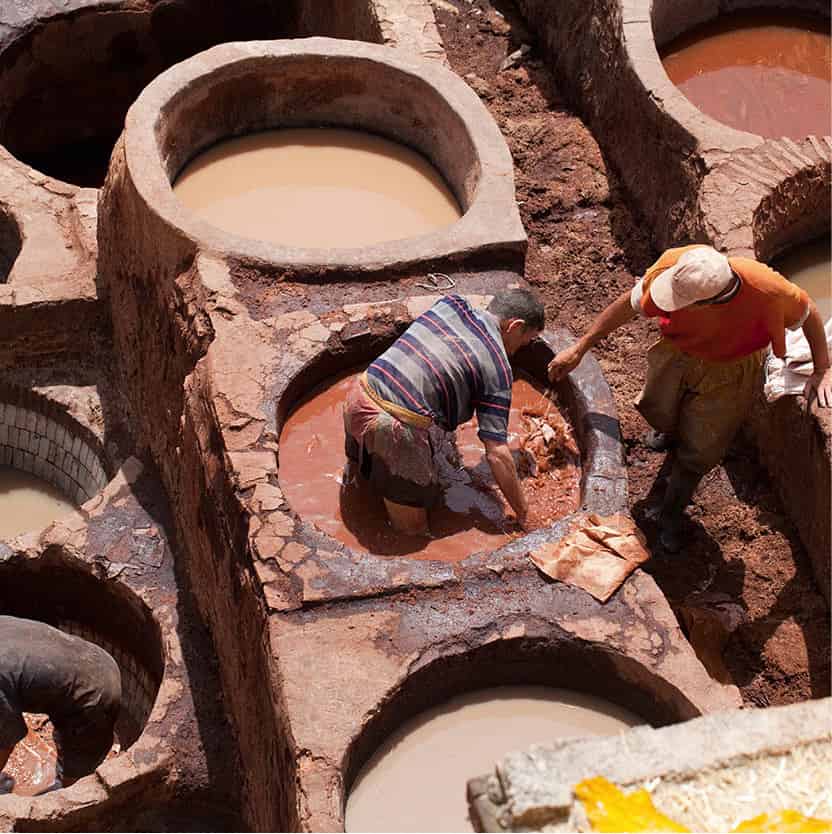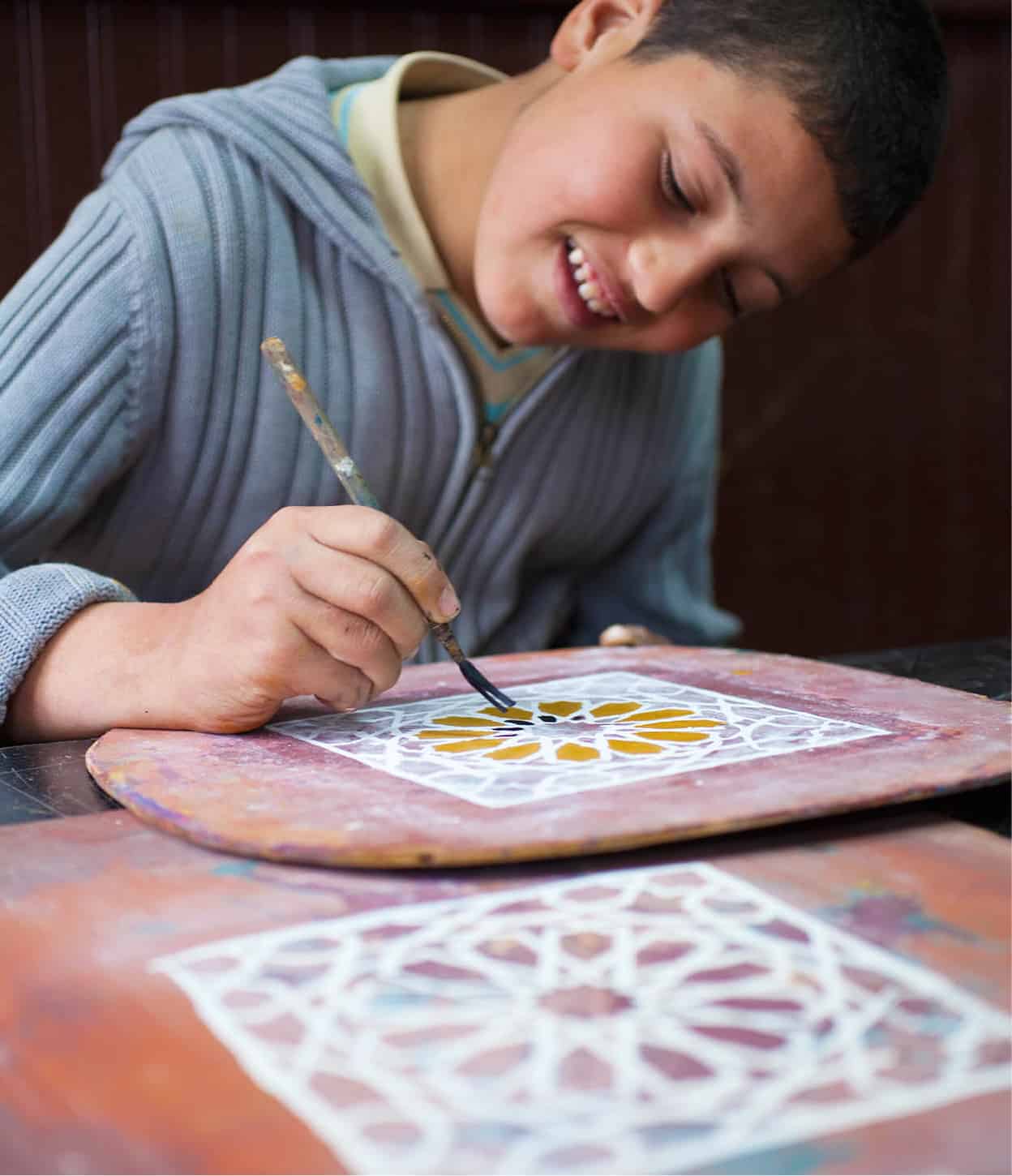Moroccan carpets can roughly be grouped into rural or urban. City carpets – usually Rabati – are influenced by the fine, oriental designs of classical Persian carpets and are intricately detailed. Rural Berber carpets – traditionally made for domestic use – are hand-woven from sheep’s wool into patterns and symbols that tell the stories of a tribe. Carpets from the Middle Atlas – zanafi – have a deep, woollen pile to keep out the cold and are usually long and narrow. The creamy white shedwi carpets of the Beni Ouarain and Beni Mguild tribes are decorated with simple black or dark brown patterns. The carpets of eastern Morocco are coloured in indigo or green and covered with Berber designs of diamonds, crosses and triangles, and the haouz carpets of the west, between the Atlas and the Atlantic, have free-floating shapes and bright colours. Kilims, or hanbels, centred on Chichaoua, are flat-woven rugs with detailed geometric designs and usually coloured in black, white and yellow on a red background. All Moroccan carpets are made by women.

Metalwork in Fez.
Ming Tang-Evans/Apa Publications
Tagines, soup bowls, ashtrays, vases, egg cups, plates – Moroccan pottery is rich and varied and encompasses both the traditional and the modern. As with carpets, it is the colours and designs of Moroccan ceramics that identify where they were created. The main ceramics centres are Fez, Safi and Meknes. The refined blue-and-white floral and abstract designs of Fez are much admired, while Safi is famous for its leafy-green glazes and for the tiles found edging traditional riads. The pottery of more remote rural regions is nearly always unglazed. Today, you can find increasingly modern designs and colours – often plain blocks of colour in crimson red, turquoise, pale pink or metallic black.

Classic pottery in Fez.
Ming Tang-Evans/Apa Publications
Studded with sequins, roughly woollen, electrically nylon, elegantly linen – Moroccan garb has many guises. Classic items of clothing include the iconic kaftan, worn by Moroccan women at weddings and other special occasions: belted, angel-sleeved ankle-length gowns, in silk, satin or nylon and embroidered to varying degrees; the jellaba, a long, hooded over-garment for both men and women, and the burnous, a short variant for men only; the hendira, a handwoven woollen cape for women, traditionally a marriage cloak; and the gandura, usually sleeveless, worn by men over other layers.
For many visitors, a pair of supple babouches, leather slippers, stacked in irresistible multi-coloured piles, are a must-have; the classic yellow babouches are still worn by Moroccan men of all ages, while white is the preferred colour when visiting the mosque. The traditional skill of crafting leather, mainly camel or goatskin, and dyeing it into a multitude of shades also produces ottomans, handbags and suitcases and delicately tooled belts. Antique saddlebags, tasselled and in faded colours, also make attractive items to take home.

Dyeing leather at the Chouaras Tanneries, Fez.
Ming Tang-Evans/Apa Publications

Berber man making silver jewellery in Tiznit.
Ming Tang-Evans/Apa Publications
Moroccan lanterns – intricately pierced and laced with coloured glass or edged in nickel – are icons of Moroccan design. But the craft of metalwork extends beyond lanterns, to tiny silver teapots, hammered and engraved copper or brass trays, antique silver perfume holders, brass door knockers rendered as ‘hands of Fatima’ and the finely wrought iron windows and balconies of traditional Moroccan homes.
The woodwork of Morocco is just as beautifully made. Cedar and pine, lemon and orangewood are aromatically fashioned by maalems, master craftsmen, into carved doors, arched entranceways, wedding chests, musical instruments and soup spoons. The fragrant thuya wood of the south – prevalent in the souks of Essaouira – is greatly sought after and made into inlaid chess sets, polished animal sculptures and jewellery boxes.
Glittering jewellers shops exhibiting a glitzy array of golden necklaces, bracelets and earrings are found in medinas across the country, often in the old Jewish quarters, or mellahs. Out of the cities, the real draw is tribal Berber silver jewellery, decorated with turquoise, agate, jade, ivory, wood and amber. Berber women love jewellery – from brooches to fasten veils and heavy silver cuffs studded with turquoise and coral, to many-layered, beaded necklaces – some, for ceremonial purposes, being as large as a small child – and earrings depicting traditional Berber symbols. Tiznit, south of Agadir, is the main centre for silver jewellery in Morocco, and it is here that you are more likely to find the genuine Berber jewellery at affordable prices.

Painting tiles in Tetouan.
Ming Tang-Evans/Apa Publications